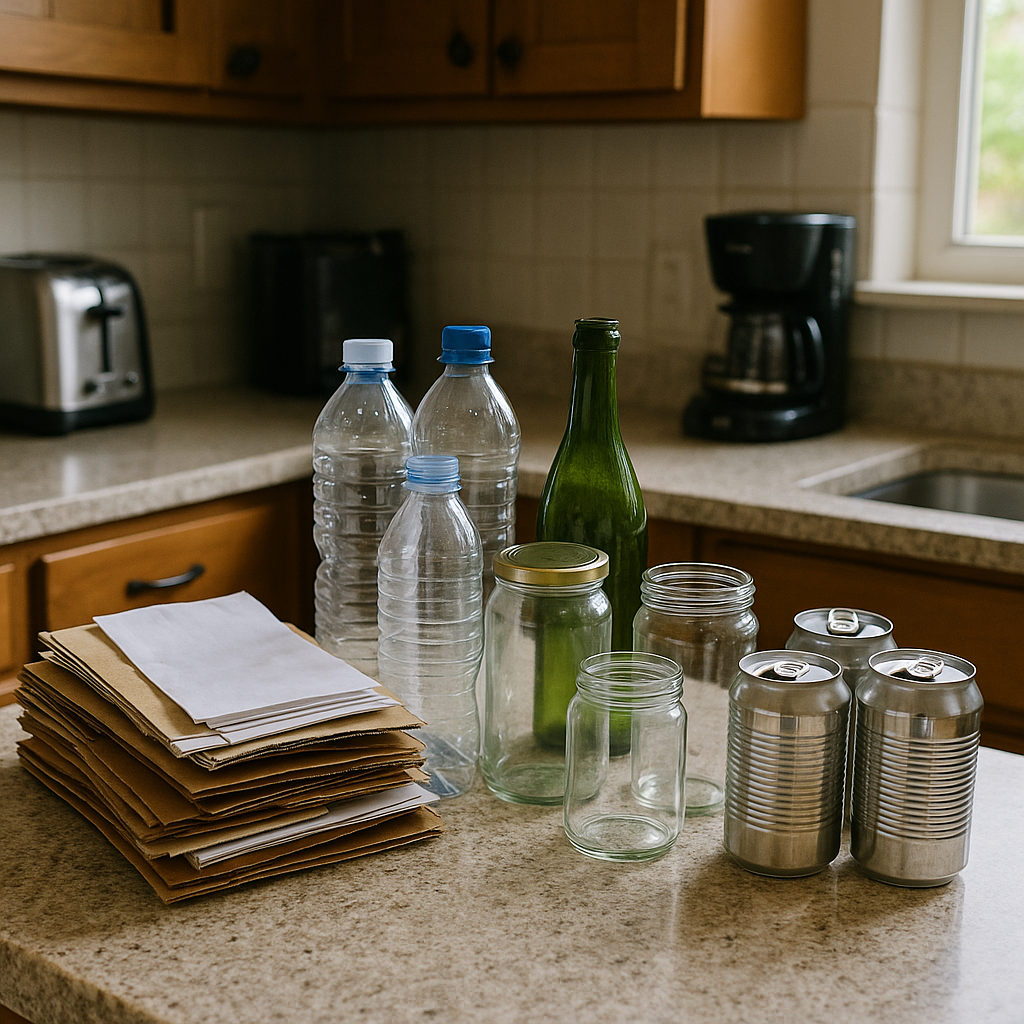5901 Botham Jean Blvd, Dallas, TX 75215
Recycling and Reusing: Practical Tips, Household Ideas, and Environmental Benefits
August 28, 2025Every day, we generate waste that impacts our environment. Recycling and reusing offer practical solutions to this growing problem. Recycling transforms used materials into new products through collection, processing, and manufacturing. Reusing extends an item’s life by finding alternative purposes for it without significant processing.
These practices form the foundation of sustainable waste management. Recycling paper reduces the need to harvest trees, and reusing glass containers prevents them from entering landfills. Both actions conserve natural resources and protect our environment.
The environmental benefits are substantial. According to EPA data, recycling and composting saved over 193 million metric tons of carbon dioxide equivalent in 2018. Recycling just 10 plastic bottles saves enough energy to power a laptop for more than 25 hours. These small actions create meaningful change.
What Common Household Items Can Be Recycled?

Most households produce a surprising amount of recyclable materials daily. Understanding what can be recycled helps reduce landfill waste and conserve resources. Here’s a breakdown of common household items that can typically be recycled.
Paper and Cardboard Products
Paper accounts for nearly a quarter of all municipal waste generated annually. Fortunately, most paper products are recyclable, including newspapers, magazines, mail (even those with plastic windows), and flattened cardboard boxes from shipping or food packaging.
Pizza boxes can usually be recycled even with grease stains. Just remove any food scraps before placing them in your recycling bin. For hardcover books, remove the binding as adhesives aren’t recyclable, while paperbacks can typically be recycled whole.
Glass and Metal Items
Glass bottles and jars are infinitely recyclable without losing quality. Rinse them before recycling and remove metal caps, which should be recycled separately. Different colored glass can generally be mixed together in your recycling bin.
Aluminum cans, food tins, and clean aluminum foil can all be recycled. Avoid crushing cans in areas with single-stream recycling, as flattened cans are harder to sort at processing facilities.
Plastics
Plastic recycling varies by location. Most communities accept plastic bottles and containers with numbers 1 and 2, but acceptance of plastics numbered 3-7 differs by program. Look for the resin identification code (the number inside the recycling symbol) to identify recyclable plastics.
Empty plastic containers of food residue before recycling. Remember that plastic bags, wraps, and films generally can’t go in curbside bins but can be recycled at many grocery and retail stores.
Special Recycling Items
Some household items require special handling and shouldn’t go in regular recycling bins:
Electronics such as computers, phones, and TVs contain valuable materials, but also potentially harmful components. Many retailers and manufacturers offer recycling programs for these items.
Batteries, especially rechargeable and lithium-ion types, should never go in regular trash or recycling. They require special handling through designated collection points or household hazardous waste facilities.
Light bulbs, particularly CFLs and fluorescent tubes containing mercury, should be taken to specific collection sites for proper recycling.
Following Local Guidelines
Recycling programs vary significantly between communities, so always check your local recycling guidelines to confirm which materials are accepted. Many municipalities provide detailed information online or through recycling apps.
A good rule of thumb: when in doubt, keep it out. Placing non-recyclable items in recycling bins can contaminate entire loads, causing more harm than good.
Remember to rinse containers before recycling. Items don’t need to be spotless, but should be free of food debris. This simple step helps ensure materials can be properly processed and transformed into new products.
How Can I Reuse Items Around the House?

Reusing household items reduces waste and gives common objects new purpose. Glass jars from pasta sauce or pickles make excellent storage containers for pantry staples like rice and beans. They also serve as attractive vases for fresh-cut flowers or containers for homemade candles.
Kitchen items offer numerous reuse opportunities. Plastic bottles can be transformed into planters by cutting off the top and adding drainage holes. Aluminum foil can soften hardened brown sugar when placed in the container overnight. Cereal box liners make excellent sandwich bags, eliminating the need for single-use plastic.
Old clothing and textiles have multiple second lives. Worn-out t-shirts and towels are great for use as cleaning rags for various household tasks. Bedsheets can be repurposed as drop cloths for painting projects or even cut and hemmed into curtains for budget-friendly window treatments.
Paper products don’t need to head straight to the recycling bin. Newspapers and magazines make creative gift wrap options with a unique, personalized touch. Cardboard tubes from paper towels can organize cables and cords, preventing tangles and making storage more efficient.
Repurposed containers solve organizational challenges throughout the home. Empty tissue boxes store plastic grocery bags for future use. Egg cartons keep small items like jewelry, buttons, or craft supplies neatly sorted. Shoe boxes become drawer dividers when cut to size, helping maintain order in cluttered spaces.
Before disposing of any household item, consider its potential new purpose. Even items like wine corks can be transformed into coasters by gluing them together in creative patterns. Adopting this mindset of viewing items as reusable can significantly reduce household waste and encourage creativity.
Reusing common items has an environmental impact beyond waste reduction. Each reused item saves the resources, energy, and emissions needed to produce a new product. This simple practice of creative reuse contributes to a more sustainable home environment.
What Are the Benefits of Recycling and Reusing?

Recycling and reusing materials bring significant environmental and economic advantages that go beyond mere waste reduction. These practices support a circular economy where resources are valued and utilized efficiently.
Environmental Benefits
Resource conservation is a major benefit of recycling. By transforming used materials into new products, we minimize the need to extract raw materials. For example, the Environmental Protection Agency reports that recycling one ton of aluminum can save up to 8 tons of bauxite ore and 14,000 kilowatt-hours of energy.
Recycling significantly decreases landfill waste. When materials are recycled instead of discarded, it reduces the accumulation of waste in landfills, helping prevent the release of methane and carbon dioxide, which are harmful gases contributing to climate change and air pollution.
Pollution reduction benefits extend to energy savings. Manufacturing with recycled materials uses significantly less energy than using new resources. For instance, producing recycled steel uses 60% less energy and results in 97% less mining waste compared to manufacturing from raw ore.
Greenhouse gas emissions are greatly diminished through recycling initiatives. According to the EPA, recycling and composting in 2018 avoided over 193 million metric tons of carbon dioxide equivalent, similar to the emissions from more than 41 million cars.
Economic Advantages
Recycling stimulates job creation across the recycling process, from collection to production. The National Recycling Coalition notes that recycling supports approximately 681,000 jobs in the United States.
The economic benefits extend further. Activities related to recycling and reuse contribute about $37.8 billion in wages and generate $5.5 billion in tax revenues, equating to 1.17 jobs, $65,230 in wages, and $9,420 in tax revenue per 1,000 tons of recycled materials.
For businesses, recycling programs offer direct cost reductions. Through efficient resource use, UK businesses reportedly save an estimated £23 billion annually. Companies that utilize recycled materials often enjoy lower waste management costs and reduced energy expenses.
Benefits of Reusing
Reusing items provides enhanced environmental benefits because it eliminates energy use associated with collection, processing, and remanufacturing. When products are reused, their lifespan is extended, easing the demand for new items and preserving the resources required to make them.
The financial benefits of reuse are also notable. Savings occur at both individual and institutional levels. Businesses using reuse programs for shipping materials, office supplies, and equipment significantly cut procurement costs.
Many communities have reuse centers where residents donate or obtain used goods. These centers not only keep items out of landfills but offer affordable options for those with limited resources.
Creating a Sustainable Future
Recycling and reusing are central to sustainable waste management, contributing to resource conservation, pollution reduction, energy savings, and economic development. They aid in mitigating climate change by reducing greenhouse gas emissions linked to production and waste management.
By engaging in recycling and prioritizing reuse, individuals and organizations promote a circular economy, keeping materials valuable for as long as possible. This approach minimizes waste while maximizing environmental and economic benefits for both present and future generations.
How Can I Incorporate Recycling and Reusing Into My Daily Life?
Incorporating recycling and reusing into your daily routine doesn’t require major lifestyle changes. Small, consistent actions can create significant environmental benefits over time. Begin by understanding your local recycling guidelines to ensure you’re sorting materials correctly. This simple step prevents contamination and increases the efficiency of recycling programs.
Setting up a dedicated recycling station at home makes sustainable practices more convenient. Use clearly labeled bins for different materials like paper, plastic, glass, and metal. Place these bins in high-traffic areas of your home where waste is commonly generated, such as the kitchen or home office.
Beyond recycling, focus on extending the life of items you already own. Glass jars can become storage containers or flower vases. Old clothing can transform into cleaning rags. Plastic bottles can serve as planters or rainwater catchers. These creative reuse strategies prevent valuable materials from entering landfills while maximizing the utility of your purchases.
We all play a role in building a more sustainable future. By making thoughtful choices about consumption and waste management, we can significantly reduce environmental impact. For professional guidance on implementing effective recycling solutions for your home or business, contact Okon Recycling at 214-717-4083.
